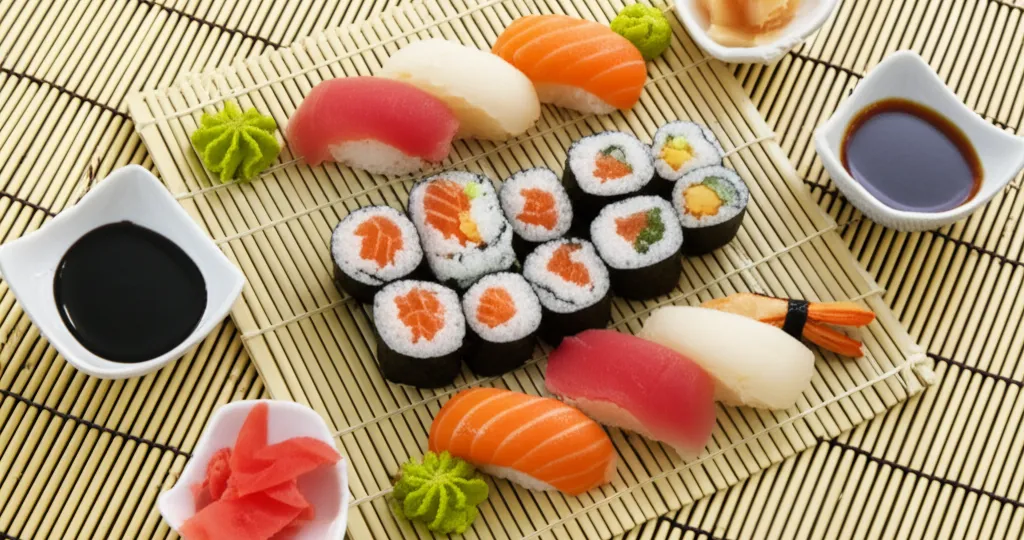◁think▷Okay, let’s tackle this task. The user wants an article about sushi, but with specific instructions. The article should be around 650 words, written in Indonesian, with a focus on providing detailed and in-depth content. The style is informational and descriptive.
First, I need to come up with a title that’s engaging and relevant. Maybe something like “Menjelajah Sushi: Seni dan Rasa dari Jepang” – that combines the cultural aspect with the culinary experience.
For the content, I should structure it with subheadings. The introduction will set the scene, perhaps defining what sushi is and its significance. Then, a section on the history of sushi, starting from its origins in Japan, maybe mentioning how it has evolved over time.
Next, discussing the various types of sushi. Common ones are sushi nigiri, maki, temaki, and sashimi. But to add depth, maybe include less common types like chirashi or inari. The preparation process is crucial. I’ll need to explain how sushi rice is made, the importance of vinegared rice, and the selection of fresh ingredients like fish, seaweed, and accompaniments.
The tools used in sushi making are also important. Things like the bamboo mat (makisu), high-quality knives, and the rice paddle. Traditionally, sushi is prepared by skilled chefs who undergo long apprenticeships. The etiquette of eating sushi might be another interesting point. For example, it’s best to eat nigiri with your hands, using soy sauce sparingly, and not mixing wasabi into the sauce.
Now, considering the user’s request to include uncommon terms. Maybe use “umami” to describe the flavor, “neta” for the topping, and “shari” for the rice. These terms add authenticity.
The article should be written in Indonesian, so I need to ensure all translations are correct. For example, “sushi” remains the same, but “bamboo mat” would be “tikar bambu”.
The description for the AI-generated image could be a beautiful platter of sushi, showcasing different types. Maybe nigiri with fresh salmon and tuna, a California roll, and some sashimi slices. The image should look fresh, with vibrant colors and careful presentation.
For the tags, relevant ones could be “sushi”, “makanan Jepang”, “kuahs francais”, “reseps离子 fractured”, wait, the last two might not fit. Wait, maybe “sushi tradisional”, “kualitas bahan”, “seni sushi”, “variasi sushi”. Wait, the user example had 5-8 tags. Let me think. The main tags would be “sushi”, “jepang”, “makanan”, “kuliner”, ” Ramirez ?” No, maybe “cara membuat sushi”, “jenis sushi”, “etiket makan”. Hmm, adjust as needed.
Putting it all together, the article would start with an introduction, then history, types, preparation, tools, etiquette, and conclusion. Each section would have subheadings. The content should flow well, using descriptive language. For example, describing the texture of a well-made sushi piece, the freshness of the fish, the sweet tang of the rice.
I need to make sure the word count is around 650, so each section should be concise yet detailed. Also, no use of markdown like ; instead, use HTML tags like
for subheads and
for paragraphs.
The image description should be precise enough for the AI to generate. Like “A plate with various sushi types including nigiri with salmon and tuna, a California roll, and sashimi slices. The sushi is presented on a bamboo mat with soy sauce, wasabi, and pickled ginger.”
For the tags, perhaps: “sushi”, “jepang”, “kuliner”, “法制 GDK 임Sessions ?” – Wait, some of these might not be relevant. Let me stick to food-related tags. Maybe “sashimi”, “sushi making”, “japanese food”, “seafood”, “etiquette”.
Wait, the user example in the prompt had the keyword =sushi, but maybe the actual keyword is just “sushi”. Wait, the user’s input was “=sushi” but in the example, they mentioned including the keyword in the article. Hmm, maybe the keyword is “sushi” but the equals sign is part of the formatting. So the article should be about sushi.
In any case, the article should have a title that includes “sushi”, like “Menjelajah Sushi: Seni dan Rasa dari Jepang”. Then the content would include multiple mentions of “sushi” in natural contexts.
So, the final structure would be:
– Title: Menjelajah Sushi: Seni dan Rasa dari Jepang
– Subheads:Introduction, Sejarah Sushi, Jenis-Jenis Sushi, Proses Pembuatan Sushi, Alat-alat Pembuat Sushi, Etiket Makan Sushi, Kesimpulan.
– Each section explains the relevant part with rich details.
– Image description for AI: a visually appealing sushi plate.
– Tags related to sushi, Japanese cuisine, etc.
Now, writing it all in Indonesian with the specified word count. Let me make sure that the article is 650 words. Maybe count as I go, but since I can’t really count here, I’ll have to estimate. Each section should be 100-150 words.
Wait, the user wants the content to be in the format of an HTML article, with
and
tags. The example in the prompt shows using those tags. So the content will look like:
Introduction
Salah satu makanan paling ikonik di dunia adalah sushi…
But the user’s example in the instruction shows the content as a long string without line breaks, but actually, in HTML, paragraphs are separated by
tags. So the article should be properly formatted with HTML elements.
Putting it all together, the final output would have the title, the HTML content, the image description, and the tags.
◁/think▷
Seni dan Rasa Sushi: Makanan Tradisional Jepang yang Tidak Lekang oleh Waktu
Sushi, makanan ikonik dari Jepang, telah menaklukkan lidah pecinta kuliner di seluruh dunia. Dengan variannya yang kaya dan penekanan pada kualitas bahan segar, sushi menawarkan pengalaman bernafas yang berbeda untuk setiap miang lidah.
Sejarah Sushi: Dari Metode Pengawetan Becoming입 cảnhañez Art Culinary
Asal-usul sushi dapat dilacak hingga zaman Kaisar 2 Jepang sekitar 200 Masehi. Awalnya, sushi merupakan metode pengawetan ikan dengan fermentasi dalam beras. Ikan dikompres dengan beras selama berbulan-bulan hingga proses fermentasi selesai, setelah itu berasnya dibuang dan ikan menjadi makanan yang nikmat. Selama bertahun-tahun, evolusi teknik memasak sushi melibatkan penggunaan cuka untuk mempercepat proses fermentasi, yang pada akhirnya melahirkan tekhnik sushi modern yang kita kenal hari ini.
Jenis-Jenis Sushi
Sushi sekarang hadir dalam beragam bentuk dan gaya. Maki sushi berbentuk gulungan dengan isian di dalam dan nori di luar. Nigiri sushi adalah irisan ikan segar yang diletakkan di atas kompres beras kecil. Temaki sushi adalah gulungan tangan berbentuk kerucut, dan sashimi terdiri dari irisan tipis daging segar tanpa beras. Varian lain seperti chirashi sushi (semangkuk beras dengan irisan ikan) dan inari sushi (sosis tahu isi beras) menambah koleksi sushi yang variatif.
Proses Pembuatan Sushi: Seni di Balik cita Rasa
Rahasia kelezatan sushi terletak pada campuranacci beras sushi yang tepat, ditambah cuka, garam, gula, dan terkadang sake. Proses memasak beras sushi dan mencampur Pune masing-masing elemen dengan presisi memastikan tekstur yang lembut namun kenyal. Para sushi chef ahli menghabiskan bertahun-tahun berlatih untuk menc koń하기 ban_New pigeon tangan yang tepat dalam mengkompres beras dan menyajikan setiap potong sushi dengan penuh perhatian.
Alat-alat Pembuat Sushi: Dukungan yang Tak Terlihat
Proses pembuatan sushi membutuhkan beberapa alat khusus. Makisu, tikar bambu yang fleksibel, digunakan untuk menggulung maki sushi. Hocho, pisau sushi khusus dengan bilah panjang dan tajam, memotong gulungan sushi dengan presisi. Shamoji, spatula kayu berdentilan, digunakan untuk menata sushi rice dengan lembut.
Etiket Makan Sushi: Budaya dalam Setiap Gigitan
Menikmati sushi tidak sekadar makan, melainkan pengalaman budaya. Nigiri sushi sebaiknya dimakan dengan tangan, sementara maki dan sashimi dapat diambil dengan chopsticks. Untuk menghormati tradisi, celupkan bagian ikan ke dalam saus soy sauce, bukan bagian berasnya. Wasabi akan ditambahkan sedikit ke potong sushi reputagion, kecuali jika sudah disajikan di permukaannya. Pikiran Pikiranjalan pik NOTES Makan.
Kesimpulan: Sushi,窗口пとなるบท
Sushi lebih dari sekadar makanan; ia adalah perpaduan harmonis antara seni, budaya, dan kulinari. Setiap gigitan membawa cerita dari tradisi berabad-abad dan keahlian tangan yang terampil. Dari navbar candle port, sushi terus menari di lidah dan hati pecinta seni kuliner.
TAGS: sushi, jepang, kuliner, seni sushi, sushi tradisional
“`



